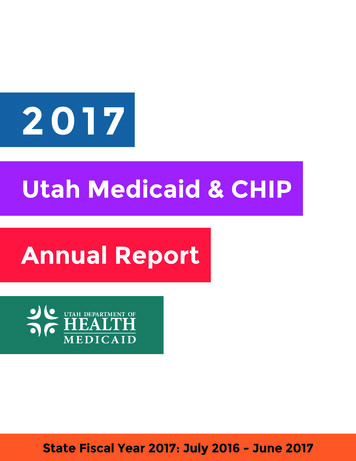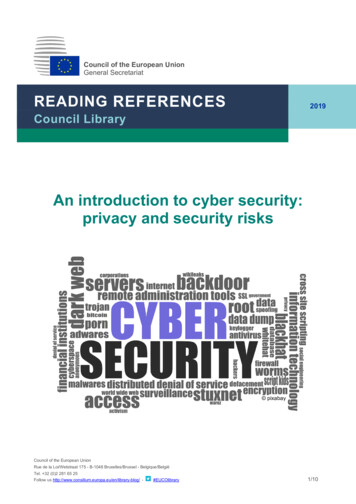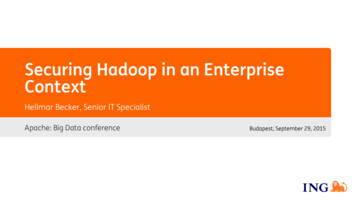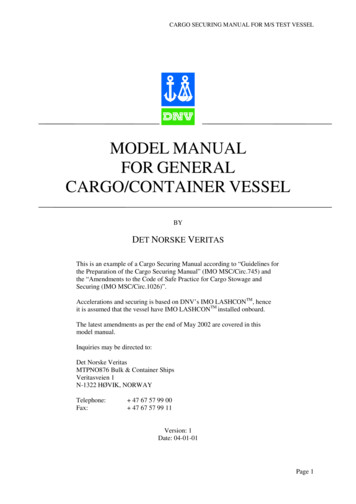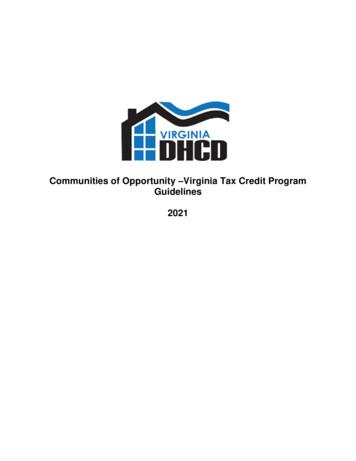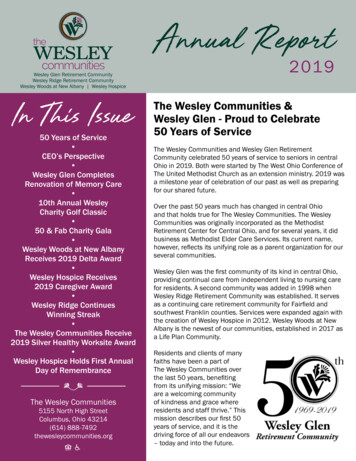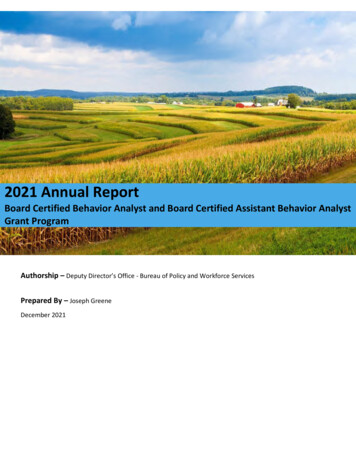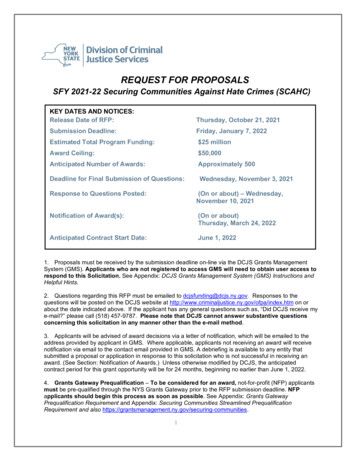
Transcription
REQUEST FOR PROPOSALSSFY 2021-22 Securing Communities Against Hate Crimes (SCAHC)KEY DATES AND NOTICES:Release Date of RFP:Thursday, October 21, 2021Submission Deadline:Friday, January 7, 2022Estimated Total Program Funding: 25 millionAward Ceiling: 50,000Anticipated Number of Awards:Approximately 500Deadline for Final Submission of Questions:Wednesday, November 3, 2021Response to Questions Posted:(On or about) – Wednesday,November 10, 2021Notification of Award(s):(On or about)Thursday, March 24, 2022Anticipated Contract Start Date:June 1, 20221. Proposals must be received by the submission deadline on-line via the DCJS Grants ManagementSystem (GMS). Applicants who are not registered to access GMS will need to obtain user access torespond to this Solicitation. See Appendix: DCJS Grants Management System (GMS) Instructions andHelpful Hints.2. Questions regarding this RFP must be emailed to dcjsfunding@dcjs.ny.gov. Responses to thequestions will be posted on the DCJS website at http://www.criminaljustice.ny.gov/ofpa/index.htm on orabout the date indicated above. If the applicant has any general questions such as, “Did DCJS receive mye-mail?” please call (518) 457-9787. Please note that DCJS cannot answer substantive questionsconcerning this solicitation in any manner other than the e-mail method.3. Applicants will be advised of award decisions via a letter of notification, which will be emailed to theaddress provided by applicant in GMS. Where applicable, applicants not receiving an award will receivenotification via email to the contact email provided in GMS. A debriefing is available to any entity thatsubmitted a proposal or application in response to this solicitation who is not successful in receiving anaward. (See Section: Notification of Awards.) Unless otherwise modified by DCJS, the anticipatedcontract period for this grant opportunity will be for 24 months, beginning no earlier than June 1, 2022.4. Grants Gateway Prequalification – To be considered for an award, not-for-profit (NFP) applicantsmust be pre-qualified through the NYS Grants Gateway prior to the RFP submission deadline. NFPapplicants should begin this process as soon as possible. See Appendix: Grants GatewayPrequalification Requirement and Appendix: Securing Communities Streamlined PrequalificationRequirement and also es.1
SFY 2021-22 Securing Communities Against Hate Crimes (SCAHC)Request for ProposalsTable of ContentsI.Introduction .3II.Funding, Applicant Eligibility and Contract Term .3A. Funding and Award Guidelines .3B. Applicant Eligibility Requirements .4C. Availability and Approved Use of State Funds .5D. Contract Term .5III.Project Description .5A. Vulnerability Assessment .5B. Permissible Costs .6C. Non-Permissible Costs .7IV.Best Practices and Reference Materials .8A. Best PracticesAppendix - Best Practices for Preparing an Effective Grant ApplicationAppendix - Best Practice Guide for Securing Your FacilityB. Reference MaterialsAppendix – State and Federal Resources for Facility SecurityV.Evaluation and Selection of Applications .8VI.Request for Proposal Questions .10VII.Notification of Awards .14VIII.Reporting Requirements .14IX.Administration of Contracts . .15X.Application Submission and Requirements .20XI.Application Checklist . .20APPENDICES: Grants Gateway Prequalification Process DCJS Grants Management System (GMS) Instructions and Helpful Hints Best Practices for Preparing an Effective Grant Application Best Practice Guide for Securing Your Facility State and Federal Resources for Facility Security Reported Hate Crime Incidents Per County Data County Population Size Data Budget Detail Worksheet and Narrative Guide Standardized Work PlanATTACHMENTS: Attachment 1 Attachment 2Vulnerability Self-Assessment ToolSubstitute Form W-92
I.INTRODUCTIONThe New York State Division of Criminal Justice Services (DCJS) seeks proposals to fund safetyand security projects at nonprofit organizations at risk of hate crimes or attacks because of theirideology, beliefs or mission. Approximately twenty-five million ( 25 million) is expected to beavailable to fund approximately 500 projects throughout New York State.The total number of hate crime incidents reported to police represent a fraction of all reported crimein the state. Hate crimes, however, target individuals, groups of individuals or property because of aperception or belief about race, ethnicity, sex, sexual orientation, religion or other characteristic asdefined by state law. This can result in these crimes adversely affecting entire communities, not justtheir intended target. New York State tracks these incidents separately from other crimes so trendscan be monitored, and the state can remain proactive in efforts to prevent hate crimes and ensurethe safety and equal treatment of all New Yorkers.Through this Request for Proposals (RFP), DCJS is continuing the Securing Communities AgainstHate Crimes Program (SCAHC) initiated in 2017 by the New York State Division of HomelandSecurity and Emergency Services (DHSES). This RFP seeks to strengthen safety and securityarrangements at the facilities of New York nonprofit organizations at risk of hate crimes or attacksbecause of their ideology, beliefs, or mission. In support of this effort, 25 million in grant fundinghas been made available on a statewide basis, with the grants administered by DCJS.DCJS enhances public safety by providing resources and services that inform decision making andimprove the quality of the criminal justice system. DCJS is a multi-function criminal justice supportagency with a variety of responsibilities, including collection and analysis of statewide crime data;operation of the DNA databank and criminal fingerprint files; administration of federal and statecriminal justice funds; identification and funding of programs that reduce crime, recidivism, andvictimization. Additionally, DCJS administers the state’s Sex Offender Registry.DCJS is committed to providing programs that improve the effectiveness of New York's justicesystem. Proposals will be rated and selected for funding consistent with the best interest of thestate. Applicants are encouraged to demonstrate in their response to this solicitation how theirproposal supports New York’s commitment to public safety.II.FUNDING, APPLICANT ELIGIBILITY AND CONTRACT TERMA.Funding and Award GuidelinesDCJS expects that approximately 25 million will be made available to support approximately500 projects. Applications will be accepted for up to 50,000 per facility. Each eligibleorganization may submit up to three (3) applications for a maximum total of 150,000. Eachfacility will require a separate application. For purposes of this grant program, a facility isdefined as a building, including recreational areas adjacent to the building. A facility that has3
previously received funding through a DHSES SCAHC award is not eligible for funding underthis RFP, although an organization may apply for grants for up to three (3) other facilities.As an example, Organization X operates a campus incorporating 3 separate facilities:a school building, a separate structure housing a daycare center with an adjacentrecreational area and a separate community center. Organization X received fundingthrough a prior DHSES SCAHC award to secure the community center. Thisorganization, if otherwise eligible (see additional eligibility information below), mayapply for and submit up to two (2) separate proposals to fund separate projects onthis campus --- the school, and the daycare center and adjacent recreational area.The community center at this campus would not be eligible to receive funding underthis RFP because it was provided funding through a prior DHSES SCAHC award.All funding must support project related costs that will be incurred during the contract period.Funding under this program must supplement, not supplant, non-grant funds that wouldotherwise be available for expenditure on the projects proposed.B.Applicant Eligibility RequirementsThis RFP requests applications to support projects that enhance the safety and security ofnonprofit organizations at risk of hate crimes or attacks due to their ideology, beliefs ormission. Nonprofit organizations that have previously received an SCAHC award throughDHSES are not eligible to apply for additional awards through this RFP to secure the samefacilities. Each applicant must be pre-qualified on-line in the New York State GrantsGateway. Please see Appendix: Streamlined Grants Gateway Prequalification Process forinstructions on how to become pre-qualified.To be eligible, applicants must meet all the following requirements: Applicants must have received a Recognition of Exempt Status Determination letter fromthe IRS pursuant to 26 USC §501(c)(3). Alternatively, the applicant may self-certify byproviding a letter affirming that the organization qualifies as a §501(c)(3) organization andis exempt from tax pursuant to 26 USC §501(a). The organization must maintain taxexempt status throughout the life of the grant. If the organization’s tax-exempt status isjeopardized or placed into question at any point during the life of the grant, theorganization must notify DCJS within fifteen (15) days; AND The applicant must be a nonprofit organization; AND Must be at risk of a hate crime or attack due to ideology, beliefs, or mission as describedby the applicant organization; AND4
Must be registered, have recently applied for registration and such application remainspending, or be exempt from registering with the NYS Attorney General’s Office, CharitiesBureau; AND Must be prequalified through the New York State Grants Gateway ties prior to application submission.C.Availability and Approved Use of State FundsGrant funding will be awarded competitively for allowable interior and exterior facilityhardening, physical security enhancements and training of staff or organization members inthe use of the security equipment to harden nonprofit facilities at risk of hate crimes. Staff orpersonnel are NOT allowable costs. Proposals must be for new projects. Grant funds cannotbe used to support projects that have been undertaken prior to award or outside the period ofthe grant contract. Further, grant funds may not be used to fund projects that have alreadybeen reimbursed through any other grant program, including but not limited to the Non-publicSafety Equipment (NPSE) Program administered by the State Education Department, or theNonprofit Security Grant Program administered by DHSES.The Securing Communities Against Hate Crimes Program (SCAHC) advances a commonunderstanding of risk management, i.e., identification of risks and vulnerabilities and corollarymethods of reducing and/or eliminating those risks and vulnerabilities. Applicants must havea facility-specific Vulnerability Assessment completed (see section III.A below for additionalinformation) which describes relevant threats and security vulnerabilities and describes howthe organization will prevent and protect against hate crimes or attacks targeting their facility.Grant funding must be proposed which will mitigate against those risks and vulnerabilities asidentified in the Vulnerability Assessment.Additional approved use of state funds and costs that are not permissible are describedunder “Program Description” below.D.Contract TermUnless otherwise modified by DCJS, the anticipated contract period for this grant opportunitywill be for 24 months, beginning no earlier than June 1, 2022.I.PROJECT DESCRIPTIONA.Vulnerability AssessmentApplicants must submit a completed application and Vulnerability Assessment for eachfacility for which grant funding is requested. The Vulnerability Assessment shall identifythreats to the facility as well as physical and/or human security vulnerabilities. Applicantsmust use the Attachment: Vulnerability Self-Assessment Tool included with this RFP to5
satisfy the Vulnerability Assessment requirement. If your organization has a VulnerabilityAssessment that has been completed within the past three years, it may be used to satisfythis requirement provided that the assessment reflects current vulnerabilities of the facility.B.Permissible CostsThe SCAHC proposal must describe the new elements requested for funding in orderto mitigate against the risks and vulnerabilities to a hate crime as identified in theVulnerability Assessment.Permissible costs to protect against potential hate crime activity include: 1.Hardening the organization’s facility, including recreational areas adjacent to thefacility through exterior and/or interior physical security enhancement; and/orProviding security training that will advance the knowledge of security personnel,staff and membership as appropriate.(If a paid trainer is to deliver training, the cost should be listed in the budgetcategory of “Consultants.” Training materials should be listed under the“Supplies” budget category.)Facility Hardening CostsPermissible costs include both internal and external facility hardening structures,devices or equipment that mitigate vulnerabilities identified in the VulnerabilityAssessment. Funding can be used for the acquisition and installation of securityequipment on real property/existing facilities owned or leased by the nonprofitorganization, specifically for prevention of, and/or protection against, hate crimes. Anyapplicant who proposes work on a leased property is exclusively responsible toensure compliance with the landlord lease agreement and associated requirements,particularly regarding structural alterations, equipment installations and anyalterations made with grant funds. Additionally, the applicant/grantee is solelyresponsible for compliance with any and all State and local permitting orenvironmental compliance requirements. Security enhancements must be for thefacility or facilities that the organization physically occupies at the time ofapplication. Allowable equipment consists of, but is not limited to, the followingexternal and internal facility hardening projects: Perimeter lighting;Door hardening/locking;Alarm systems;Camera-based security systems;Access control systems;Perimeter fencing, barriers, bollards;Blast resistant film for windows/shatter resistant glass;6
Interior door hardening/locking mechanisms;Panic Button/Lock-Down systems;Public Address (PA) SystemsPlease note that external security vulnerabilities should be given priority beforerequesting internal security projects under this grant program.Please refer to Appendix: Best Practice Guide for Securing Your Facility for furtherguidance on recommended security considerations and enhancements.2.Security Training CostsThe SCAHC Program for nonprofit organizations allows costs to train securitypersonnel and other appropriate staff or organization members to prevent and protectagainst acts of security threats and hate crimes. Allowable training topics are limitedto the protection of physical security and training that will advance the knowledge ofsecurity personnel and/or staff or membership about hate crime activity, suspiciousbehavior; emergency evacuation procedures and similar topics that will secure theorganization.All training will require prior DCJS approval and must be within the United States,preferably within New York State. Out of state travel must be requested in writing andapproved in writing by DCJS.Allowable training costs include, but may not be limited to, the following: C.Attendance fees for training;Costs for training materials and supplies;Travel related costs to attend training.Non-Permissible CostsThe following projects and costs are not permissible for award consideration: A project at a facility that has previously been funded through an SCAHC grantthrough DHSES;Anticipated security costs for facilities not yet built or existing;Security costs for facilities not being occupied by the organization;Personnel costs, including the hiring of security or safety personnel;General-use and maintenance expenditures;Overtime and backfill costs;Ancillary construction costs;The development of risk/vulnerability assessment models;Proof-of-concept initiatives;Organizational operating expenses or overhead costs;Reimbursement of pre-award costs or grant writing costs; and7
II.Indirect costsBEST PRACTICES AND REFERENCE MATERIALSA. Best PracticesSee Appendices “Best Practices for Preparing an Effective Grant Application" and “BestPractice Guide for Securing Your Facility” included in this RFP.B. Reference MaterialsPlease see Appendix: State and Federal Resources for Facility Security included in thisRFP.III.EVALUATION AND SELECTION OF APPLICATIONSTier I EvaluationThe Tier I Evaluation assesses whether proposals satisfy minimum “pass/fail” criteria for funding. Allproposals will be initially screened by DCJS or other state agency reviewers to determine theircompleteness using the following criteria: Proposal was received by the published deadline;Applicant is eligible as defined by this solicitation; andApplicant is an eligible, prequalified entity in the Grants Gateway. This prequalificationrequirement may be satisfied through the traditional prequalification process or byprequalifying through a new Securing Communities Streamlined Prequalification Process.Information on prequalifying in Grants Gateway can be found ties.To pass Tier I, the submitted proposals shall include: Answers to all questions 1-14 as presented in this RFP. Questions must be answered in theQuestions tab of GMS and include a Word copy attachment in GMS;Budget detail and justification provided in GMS Budget tab itemizing eligible expenses insupport of the project;Completed Project Work Plan. A standardized project work plan is included as an Appendixto this RFP and should be copied into the Work Plan tab of GMS.All attachments and required documents:oCompleted Vulnerability Assessment – See Attachment: Vulnerability SelfAssessment Tool. Complete the Assessment and upload as an attachment in theDCJS electronic grants management system, GMS. Each facility requires a separate8
application; and a separate Vulnerability Assessment must be completed for eachfacility for which funding is requested.oA color, ground-level photo of the front façade of the facility and/or recreational area—close enough to show the location, but far enough away to show the immediatesurroundings of the location for each application. The photo should be labeled withthe name and address of the facility submitted as an attachment in GMS.oSecuring Communities Grants Streamlined Prequalification Certificate or StatusHistory Report from Grants Gateway showing a prequalification status of “DocumentVault Prequalified.” Submit as attachment in GMS.oIf you used the Streamlined Prequalification process, you must upload your IRS 501(c) 3 determination letter or statement of exemption on letterhead and a substitute W9 form as attachments in GMS.Any proposal that does not meet each of these conditions shall be subject to disqualificationfrom further review.Tier II EvaluationDCJS or other state agency staff reviewers will evaluate proposals that successfully pass the Tier IEvaluation. A standard rating tool will be used to score responses to questions provided in theproposal (see Questions section for additional information). The maximum proposal score basedupon responses to the questions will be 100 points. Applicants that have not previously received aSCAHC award from DHSES will receive 5 bonus points. Each response will be scored, and allscores will be totaled - including bonus points - resulting in an overall score. The final score will bedetermined by averaging Team Reviewers’ overall scores for each proposal. Applicants must attaina minimum proposal score of 70 points to be eligible for funding. DCJS may, at its discretion,request additional information from an applicant as deemed necessary. In the event of a substantialscoring disparity between reviewers, an additional reviewer may rate the affected proposals and theaverage of all the scores will determine the final average score of the proposal. In the event of a tiescore among applicants, and where both applicants cannot be selected, the applicant with thehighest risk score will be given priority.Tier III EvaluationThe Tier III Evaluation will be conducted by designated DCJS executive staff. During the Tier IIIEvaluation, applicants shall be selected for funding and award amounts shall be determined throughconsideration of some or all the following: Tier II Evaluation scoring and comments, strategicpriorities, overall risk score of each application, available funding and best overall value to New YorkState.Final award decisions will be made by DCJS in accordance with the best interests of the State.9
Nothing herein requires DCJS to approve funding for any applicant.The DCJS Executive Deputy Commissioner or designee will make final decisions regarding approvaland individual award amounts based on the quality of each submission, the recommendations of thereviewers, specific criteria set forth in this solicitation and, where applicable, geographic balance andcomparative crime and/or risk level. Awards must be approved by the Division of the Budget andmay also require Attorney General and Office of the State Comptroller approval. All awards aresubject to availability of state funds.IV.REQUEST FOR PROPOSAL QUESTIONSImportant Reminders - In addition to answering the questions below and completing anyother contractual requirements described in this RFP, all Applicants are required to completeand/or submit the following: Securing Communities Grants Streamlined Prequalification Certificate or Status HistoryReport from Grants Gateway showing a prequalification status of “Document VaultPrequalified.” Submit as attachment in GMS. If you used the Streamlined Prequalification process, you must upload your IRS 501 (c) 3determination letter or statement of exemption on letterhead and a substitute W-9 form asattachments in GMS. See Attachment: Substitute W-9 in this RFP. Completed Vulnerability Assessment – See Attachment: Vulnerability Self-Assessment Tool.Complete the Assessment and upload as an attachment in the DCJS electronic grantsmanagement system, GMS. Each facility requires a separate application and a separateVulnerability Assessment must be completed for each facility for which funding is requested. A color, ground-level photo of the front façade of the facility and/or recreational area —closeenough to show the location, but far enough away to show the immediate surroundings of thelocation for each application. The photo should be labeled with the name and address of thefacility submitted as an attachment in GMS.Any proposal that does not meet each of the above shall be subject to disqualification from furtherreview. See RFP Section V. Evaluation and Selection of Applicants for additional information.RFP QuestionsApplicants must respond to the questions below within the DCJS electronic grants managementsystem - GMS, as instructed. GMS instructions are located as an Appendix to this solicitation.First, please prepare responses to questions in a Microsoft Word Document using Arial, 11point font and 1.5 line spacing. Responses should then be copied and pasted to GMS under theQuestions “Tab” of the application. Applicants are also required to attach the Microsoft Word10
document with responses to the questions using the Attachments Tab on GMS.Responses to the questions will be scored and are the basis for Tier II Evaluation fundingrecommendations. Note: The aggregate scoring value assigned to all questions equals a totalpossible score of 100 points, plus 5 bonus points if an organization has not previously received agrant under the DHSES Securing Communities Against Hate Crimes Program. Applicants mustattain a minimum proposal score of 70 points to be eligible for funding. All questions, including subsections and those which have no point value, must be answered.Section 1 – Questions 1- 4 Organization Background & Overview (no points awardedfor this section)1.Identify the type of facility for which you are seeking funding as one of thefollowing: House of Worship; Nonprofit School (K- ); Nonprofit Day Care; NonprofitCommunity Center; Nonprofit Cultural Museum; Nonprofit Day Camp; NonprofitResidential Camp; or Other (specify). (0 Points)2.Provide your Organization’s Mission Statement. (0 Points)3.Provide a narrative to describe the nonprofit Organization. Information must include,at a minimum: (0 Points)a) Size of Membershipb) Number of People Servedc) Community Servedd) Primary Use of Facilitye) Days & Hours of operationf) Peak Occupancy4.Describe your Organization's risk of a hate crime based on its ideology, beliefs ormission. Include if there is a symbolic value of the site as a highly recognizednational, statewide, local or historical institution that renders the organization as apossible focus of a hate crime. (0 Points)Section 2 – Question 5 - Vulnerability Assessment (maximum 30 points)5.Applicants must complete and upload as part of their application submission aVulnerability Assessment. (See Attachment: Vulnerability Assessment.) TheAssessment will be scored and must be specific to the location for which you areseeking funding. Please note: Each requested Facility requires its own VulnerabilityAssessment and GMS Application. The completed and attached VulnerabilityAssessment should:a) Clearly identify the perceived threats to the facility. (0-10 points)11
b) Clearly identify the vulnerabilities of the facility. (0-10 points)c) Describe how the vulnerabilities are linked to the threats. (0-10 points)Section 3 – Questions 6-10 - Risk Assessment (maximum 45 points)6.Is there a history of hate crimes at the facility? If Yes, provide a narrative for each. Ifyou have documentation of hate crime history, such as police reports or insurancedocumentation, please provide them as an attachment. (0-3 points)7.Does the location of the facility contribute to the risk of a hate crime incident? If so,please describe. (0-2 points)8.Describe how the proposed facility hardening equipment and/or security training willmitigate the identified threats and vulnerabilities or enhance existing securitymeasures. (0-15 points)9.Answer the following as applicable:a).b).c).10.What is the number of events at the facility per year? (0-5 points)What is the largest Event Attendance at the facility? (0-5 points)What is the average daily population at the facility? (0-5 points)APPLICANTS ARE NOT REQUIRED TO COMPLETE OR SUBMIT ANYTHING FORQUESTION #10. The following is provided for information:Risk demographics – Applications will receive the following points based on theinformation provided in Appendix: Reported Hate Crime Incidents for County andAppendix: County Population Size.a).Reported Hate Crime Incidents for County (0-5 points)b).County Population Size (0-5 points)Section 4 – Questions 11-13 - Budget Details and Workplan (maximum 25 points)11.Operating Budget Detail and Justification (0-20 points)a)Using the Budget Detail Worksheet and Budget Narrative sheet as a guide,enter the allowable costs into the operating budget directly into the Budget“Tab” of the GMS application. Prepare a line item budget, includingjustification, by appropriate category of expense (e.g., Equipment,etc.). Personnel positions, operating costs, and indirect costs are not allowedexpenses. Budgets should reflect total projected costs for a 24-month contractperiod and be limited to eligible costs as described in the RFP. Operatingbudgets must not exceed the applicant’s maximum eligible award amount of12
50,000 per application. A separate application must be submitted for eachfacility.b)If a paid trainer is to deliver training, the cost should be listed in the budgetcategory as “Consultant Services.” Training materials should be listed underthe “Supplies” budget category.c).Consultant Services: All consultant services must be obtained in a mannerthat provides for fair and open competition. The rate for a consultant shouldnot exceed 650 for an eight-hour day (not including travel and subsistencecosts). A rate exceeding 650 per eight-hour day requires prior writtenapproval from DCJS and may be approved on a case-by-case basis whereadequate justification is provided, and expenses are reasonable andallowable. A grant award recipient obtaining consultant services that cost inexcess of 10,000 must use a competitive bidding process. A grant awardrecipient who proposes to o
Proposals must be received by the submission deadline on-line via the DCJS Grants Management System (GMS). Applicants who are not registered to access GMS will need to obtain user access to . Management System (GMS) Instructions and Helpful Hints. 2. Questions regarding this RFP must be emailed to dcjsfunding@dcjs.ny.gov. Responses to the .
